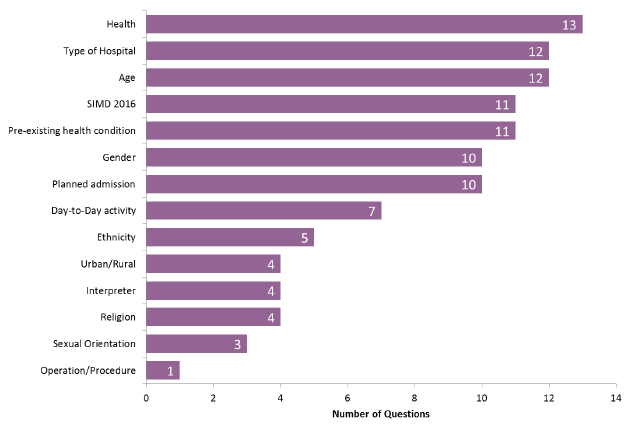Inpatient experience survey 2016, volume 3: exploring differences in experience
This report explores the differences in self-reported experience of people who responded to the inpatient experience survey 2016.
This document is part of a collection
Results - Hospital And Ward Environment
Summary
The survey results show that 89 per cent of people were positive about the overall hospital and ward environment.
All the characteristics investigated indicated a significant impact on differences seen in responses relating to people's experience on the hospital ward. In general older people, males and people staying in general and other type hospitals are significantly more positive for all aspects of the ward environment.
People who reported fair or poor health; live in SIMD 4 or SIMD 5 (least deprived) areas and those who were admitted as an emergency were significantly more negative for all aspects of the ward environment.
The hospital and ward environment
Fourteen of the survey questions relate to people's experience of the ward and the hospital environment. All characteristics investigated are associated with differences seen in reported experience for these questions (Figure 5).
Figure 5: Number of questions affected by various characteristics - hospital and ward environment

Hospital visiting
All characteristics related to hospital visiting questions are detailed in Table 5. As with other sections within this report, age and gender show some differences regarding experiences for questions relating to hospital visiting, with older people being more positive than younger and males more positive than females.
People with more than one long term health condition are significantly more negative, as are those who describe their health as fair or poor.
People living in a remote rural location are significantly more negative regarding visiting hours compared to those living in large urban areas, whereas those living in accessible rural areas are significantly more positive.
Table 5: Significant response compared to reference group - hospital visiting
| Question |
Positive |
Negative |
|---|---|---|
| Were hand-wash gels available for patients and visitors to use |
Age 35-75+; |
Emergency admissions; |
| Were you happy with the visiting hours |
Age 35-75+; |
Emergency admissions; |
| Did you feel you were able to spend enough time with the people that matter to you (e.g. family and friends) |
Age 25-75+; |
Fair and poor health; |
Ward Environment
All characteristics related to ward environment questions are detailed in Table 6. As with the hospital visiting, age and gender show some variation regarding questions relating to ward environment, with older people being more positive than younger and males more positive than females.
The hospital type has shown to describe some of the variation seen with people who have stayed in a general or community hospital being significantly more positive regarding the cleanliness of the ward and bathrooms than those staying in teaching hospitals, although those in large general hospitals were significantly more negative for ward cleanliness. People who live in SIMD 4 or SIMD 5 (least deprived) areas were significantly more negative regarding ward and bathroom cleanliness and the food and drink received. People who reported their general health as fair or poor were significantly more negative about their ward environment.
Table 6: Significant response compared to reference group - ward environment
| Question |
Positive |
Negative |
|---|---|---|
| Main ward or room was clean |
Age 75+; |
Emergency admissions; |
| Bathrooms and toilets were clean |
Age 75+; |
Emergency admissions; |
| Happy with the food/meals received |
Age 35-75+; |
Fair and poor health; |
| Happy with the drinks received |
Age 55-75+; |
Emergency admissions; |
| Equipment used for treatment was clean |
- |
Fair and poor health |
Ward Atmosphere and noise
All characteristics related to ward atmosphere and noise questions are detailed in Table 7. People who have been treated in general and other type hospitals are significantly more positive for all questions relating to the ward atmosphere and noise. Those aged over 45 were significantly more positive on those questions which asked about getting help within a reasonable time, knowing which nurse was in charge and the overall rating for the hospital environment.
People who were admitted as an emergency were significantly more negative for questions relating to noise, feeling threatened and getting help within a reasonable time as well as the overall rating for the hospital environment. People living in SIMD 5 (least deprived) areas were significantly more negative than those living in SIMD 1 (most deprived) for almost all questions about the ward atmosphere and noise.
Table 7: Significant response compared to reference group - ward atmosphere and noise
| Question |
Positive |
Negative |
|---|---|---|
| Not bothered by noise at night from other patients |
Other, community and general hospitals |
Emergency and something else admissions; |
| Not bothered by noise at night from hospital staff |
Males; |
Emergency and something else admissions; |
| Received assistance within a reasonable time |
Age 35-75+; |
Emergency and something else admissions; |
| Did not feel threatened by other patients or visitors |
- |
Emergency and something else admissions; |
| Knew which nurse was in charge of the ward |
Age 45-75+; |
Fair and poor health; |
| Overall, rate the hospital environment |
Age 45-75+; |
Emergency and something else admissions; |
Contact
Email: Nicola Kerr
There is a problem
Thanks for your feedback